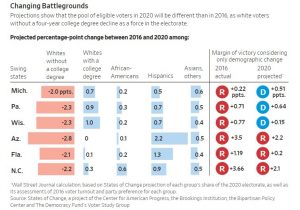The following article by Ruy Teixeira, author of The Optimistic Leftistand other works of political analysis, is cross-posted from his blog:
The case against the Democratic nominee in 2020, whomever he or she may be, is simple. Trump is the incumbent! The economy’s good! This recipe for re-election can’t be beat, so he can’t be beat. So have concluded a number of allegedly savvy pundits whose sad duty it is to deliver this bad news to the Democrats.
But perhaps they’re not as smart as they think they are. Alan Abramowitz has the case against the case on Sabato’s Crystal Ball.
“Since the end of World War II, three incumbent presidents have lost their bids for reelection — Gerald Ford in 1976, Jimmy Carter in 1980, and George H.W. Bush in 1992. Carter and Bush suffered from approval ratings that were well under water and Ford, while personally popular, was damaged by his association with his disgraced predecessor, Richard Nixon. All eight successful incumbents had net approval ratings that were either positive or, in the cases of Harry Truman (-4) and George W. Bush (-1), only slightly negative, in the months preceding their elections. In contrast, Donald Trump’s approval rating has remained mired in negative territory from the beginning of his presidency. As of Wednesday, his net approval rating stood at -10.8% (approval 42.2%, disapproval 53.0%), according to the FiveThirtyEight weighted average of recent polls. Moreover, polls measuring the intensity of these opinions have consistently found that those strongly disapproving of Trump’s performance outnumber those strongly approving by a fairly wide margin. In a Jan. 7-9 YouGov poll, for example, 45% of Americans strongly disapproved of Trump’s job performance compared with 26% who strongly approved….
According to recent research on congressional elections, the advantage of incumbency has declined sharply in recent years as a result of growing partisan polarization. Gary Jacobson of the University of California, San Diego has shown that voters have become increasingly reluctant to cross party lines to support incumbents based on their voting records or constituency service. The same logic may well apply at the presidential level, especially with an incumbent like Trump whose electoral strategy is based on reinforcing partisan divisions among the public. Indeed, Trump’s presidency has produced the sharpest partisan divisions in job approval ratings in the history of public opinion polling. In a December Quinnipiac poll, for example, 91% of Republican identifiers approved of Trump’s performance with 79% strongly approving. In contrast, 94% of Democratic identifiers disapproved of Trump’s performance with 89% strongly disapproving.
Rather than trying to expand his electoral coalition by appealing to Democrats and independents, Trump’s strategy for 2020 appears to be based almost entirely on energizing and mobilizing the Republican base. The problem with this approach, however, is that efforts to energize and mobilize the Republican base also energize and mobilize the Democratic base. Thus, the 2018 election produced the highest turnout for any midterm election in over a century and big gains for Democrats, and recent polls have found that voter interest in the 2020 election is very high among Democrats as well as Republicans….
Despite the solid economic numbers, however, there are good reasons to believe that the economy may not be as big an advantage for Trump as some analysts, and the president himself, believe. For one thing, the rate of economic growth under Trump has actually been fairly modest and consistent with that under his predecessor, Barack Obama. Economic forecasts generally have the U.S. economy expanding a rate of about 2% during the first half of 2020. The average growth rate of GDP for incumbent presidents since World War II is 3.9%. And while unemployment is near record low levels, gains from the growing economy have been concentrated heavily among the wealthiest Americans.
Another reason why the president may not receive much political benefit from a growing economy is partisan polarization. John Sides of George Washington University has recently shown that public opinion about the state of the U.S. economy is now far more divided along party lines than in the past. Republicans generally have very favorable opinions about economic conditions and credit the president for producing those results. Democrats, on the other hand, are far less sanguine about the economy and give the president far less credit for any positive results. As a result, Sides argues, Trump may receive less benefit from positive economic trends than earlier presidents who presided over growing economies…..
Based on his current net approval rating of approximately -10 and the expected growth rate of real GDP during the second quarter of 2020, Trump would be expected to win approximately 237 electoral votes — well short of the 270 needed to win. Given the fairly large standard error of this estimate, a reflection of the small number of elections it is based on, the prediction of a Trump defeat is far from certain — he would still have about a 30% chance of winning. But these results suggest that Trump begins 2020 as a clear underdog.
Abramowitz concludes on a cautionary note that Democrats would do well to heed:
“The biggest unknown about the upcoming election is the identity of President Trump’s Democratic opponent. While a presidential election with a running incumbent is largely a referendum on the incumbent’s performance, the political appeal and campaign ability of the challenger also matters. The more the campaign and the election revolve around the president’s record and performance, the better the chance that he will be defeated. And while Trump and his allies will undoubtedly try to portray any Democratic challenger as a radical socialist whose extreme policies would destroy the economy and embolden America’s adversaries, some potential Democratic candidates might make that task easier than others.”









